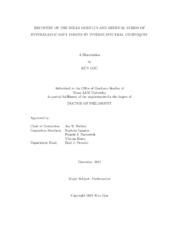| dc.contributor.advisor | Walton, Jay R | |
| dc.creator | Gou, Kun 1981- | |
| dc.date.accessioned | 2013-03-14T16:16:26Z | |
| dc.date.available | 2014-12-12T07:18:55Z | |
| dc.date.created | 2012-12 | |
| dc.date.issued | 2012-11-15 | |
| dc.date.submitted | December 2012 | |
| dc.identifier.uri | https://hdl.handle.net/1969.1/148199 | |
| dc.description.abstract | Inverse spectral techniques are developed in this dissertation for recovering the shear modulus and residual stress of soft tissues. Shear modulus is one of several quantities for measuring the stiffness of a material, and hence estimating it accurately is an important factor in tissue characterization. Residual stress is a stress that can exist in a body in the absence of externally applied loads, and beneficial for biological growth and remodeling. It is a challenge to recover the two quantities in soft tissues both theoretically and experimentally. The current inverse spectral techniques recover the two unknowns invasively, and are theoretically based on a novel use of the intravascular ultrasound technology (IVUS) by obtaining several natural frequencies of the vessel wall material.
As the IVUS is interrogating inside the artery, it produces small amplitude, high frequency time harmonic vibrations superimposed on the quasistatic deformation of the blood pressure pre-stressed and residually stressed artery. The arterial wall is idealized as a nonlinear isotropic cylindrical hyperelastic body for computational convenience. A boundary value problem is formulated for the response of the arterial wall within a specific class of quasistatic deformations reflexive of the response due to imposed blood pressures. Subsequently, a boundary value problem is developed from intravascular ultrasound interrogation generating small amplitude, high frequency time harmonic vibrations superimposed on the quasistatic finite deformations via an asymptotic construction of the solutions. This leads to a system of second order ordinary Sturm-Liouville problems (SLP) with the natural eigenfrequencies from IVUS implementation as eigenvalues of the SLP. They are then employed to reconstruct the shear modulus and residual stress in a nonlinear approach by inverse spectral techniques.
The shear modulus is recovered by a multidimensional secant method (MSM). The MSM avoids computing the Jacobian matrix of the equations and is shown to be convenient for manipulation. Residual stress is recovered via an optimization approach (OA) instead of the traditional equation-solving method. The OA increases the robustness of the algorithms by overdetermination of the problem, and comprehensive tests are performed to guarantee the accuracy of the solution. Numerical examples are displayed to show the viability of these techniques. | en |
| dc.format.mimetype | application/pdf | |
| dc.subject | IVUS | en |
| dc.subject | arterial wall | en |
| dc.subject | inverse spectral problems | en |
| dc.subject | residual stress | en |
| dc.subject | shear modulus | en |
| dc.title | Recovery of the Shear Modulus and Residual Stress of Hyperelastic Soft Tissues by Inverse Spectral Techniques | en |
| dc.type | Thesis | en |
| thesis.degree.department | Mathematics | en |
| thesis.degree.discipline | Mathematics | en |
| thesis.degree.grantor | Texas A&M University | en |
| thesis.degree.name | Doctor of Philosophy | en |
| thesis.degree.level | Doctoral | en |
| dc.contributor.committeeMember | Lazarov, Raytcho | |
| dc.contributor.committeeMember | Narcowich, Francis J | |
| dc.contributor.committeeMember | Kinra, Vikram | |
| dc.type.material | text | en |
| dc.date.updated | 2013-03-14T16:16:26Z | |
| local.embargo.terms | 2014-12-01 | |


